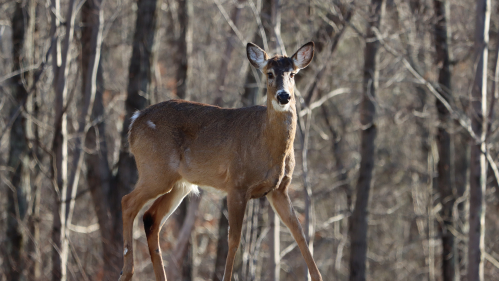The Impact of White-Tailed Deer on New Jersey Farming

A small group of New Jersey farmers lost nearly $1.3 million to deer damage in 2019, according to a new report by Rutgers Cooperative Extension (RCE) and the Rutgers New Jersey Agricultural Experiment Station (NJAES).
In the report, “White-Tailed Deer and the Hidden Costs to Farmers’ Livelihoods: A Case Study of New Jersey Stories,” researchers conducted in-depth case studies of 27 farmers about their experiences, some dating back to the 1960s, with white-tailed deer regarding environmental damage, safety concerns, management challenges and impacts to operations as the number of deer has grown.
Densities of 10 deer per square mile are recommended to maintain social, economic and ecosystem integrity. But for the farms included in the case studies, deer density estimates range from 60-239 deer per square mile, according to a study done by Steward Green for the New Jersey Farm Bureau.
Interviews were conducted between October 2020 and March 2021 with farmers from Atlantic, Burlington, Cape May, Cumberland, Salem, Hunterdon, Mercer, Monmouth, Passaic, Somerset and Warren counties who collectively owned 4,185 acres and rented 8,769 acres.
They “conservatively estimated” $1.3 million includes deer damage to crops and reduced yields ($520,940) and deer-related “hidden costs” that can be assigned a dollar value ($755,200). Crop damage from other wildlife species accounted for additional losses ($97,749).
Other impacts include abandoning fields, not being able to grow preferred crops, replanting damaged crops, changing rotations, weeds competing with crops, using more fertilizers and herbicides, soil damage, time and money spent on management activities, and the emotional toll.
But not all impacts can be assigned a dollar value, said Joseph Paulin, a report co-author and conservation expert with RCE and NJAES. The report includes personal stories of how families have been significantly impacted by deer.
“It used to get kind of depressing. A few weeks before Christmas, bucks would come in rubbing right before you were about to sell the trees. That’s a loss of $35,000 per year,” said one farmer.
“Hidden costs are substantial and for many farmers caused greater damage than direct deer destruction to crops,” said Nazia Arbab, a report co-author and assistant professor in the Department of Agricultural, Food and Resource Economics at Rutgers.
The report provides recommendations for improving deer management in the state, including raising public awareness, land access, management in suburban areas and on public lands, and more venison donation programs to help local foodbanks.
“Such knowledge is essential for expanding and enhancing deer management and future policy development,” said report co-author Brian Schilling, director of Rutgers Cooperative Extension.
“In many areas, especially around farms, there needs to be more balance,” said Paulin. “It is important to ensure there is always a healthy deer population while working towards minimizing safety concerns and impacts to farms and forests throughout the state.”


